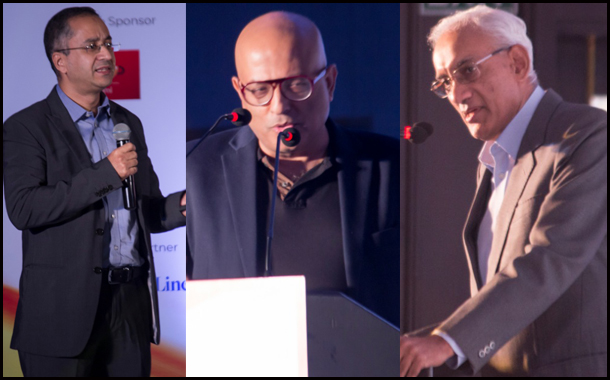Chennai: The inaugural edition of LeaderSpeak, a thought leadership forum for marketing, advertising and media by TVNews4u.com, was hosted in Chennai on 10 August.
In the first six months of 2018, the four South markets saw over 15,000 new advertisers in print, 1200 on television and over a 1000 on radio, revealed LV Krishnan, CEO, TAM Media Research, in his address to delegates at the inaugural thought leadership forum on marketing, media and advertising curated by TVNews4u.com on 10th August.
“There is an opportunity for growth in hyper-local and local advertising media. There is also opportunity in local brands giving national brands a run for their money. National brands are likely to spend higher budgets in South markets just to face off competition,” he added.
He named RB, ITC and Wipro among companies that have intensified their focus on the South, as evidenced from their media spends. Besides advertising, the South focus is also evident from rebranding of Dabur’sLalDantManjan as Sigappu Pal Podiand in HUL’s intent to acquire Adityaa Milk.
High disposable income, flourishing traditional retail alongside modern trade and availability of local media to build awareness in the South are among factors driving growth in the ‘United States of South India’, said the speaker. The region is responsible for 56 percent of volume sales for household and personal care and also 41 per cent of e-commerce sales, he noted.
Print is Growing
Delivering the inaugural address on ‘What’s Coming Next in Media and Communication’, Srinivasan K Swamy, Chairman, RK SwamyHansa Group, touched upon the global scenario and observed similarities with India, and also some key differences.
He quipped, “India is probably the only country where we have the 19th, 20th and 21st century living together.”
He underlined that unlike in the west, print as a medium was still growing in India, and explained, “According to the ABC (Audit Bureau of Circulation), print is growing and it has been growing consistently over the last 10 years. Nowhere else in the world do we see this growth in print.”
Indian language print media is growing at a faster clip than English media, he noted, pointing to a trend in the advertising and marketing universe of not giving print its due.
He said, “Print is still a popular medium, it is still growing. It has still got traction across India. But still, as an industry, we seem to be giving up on it.”
Media Investment 2.0
Vikram Sakhuja, CEO – Madison Media and OOH, delivered the keynote address on the future of media investment. Explaining the metrics of the future, he observed that marketing investments in future would be made along the consumer journey – a transition that not all clients have made yet, but would, eventually, in his view.
On the subject of branded content, he underlined the need for a thought-through content strategy, and said, “Anything strategic should be fundamental to the business.”
He also emphasized the need for content to have a data layer. Citing the example of Netflix, he explained, “It is not enough to be a content creator. All that content has to help you find out more about the consumer, which allows you to actually service them better.”
Hyper-local Future of News
Noting that against over 183 mn TV households in India, over 101mn still did not have access to the medium, AvinashKaul, COO Network18 & MD, A+E Network TV18, underlined the headroom for growth. The growth of regional television viewing between January 2016 and June 2018 at 35 per cent was higher than the national growth rate of 30 per cent, he added. In the same period, while Hindi news genre grew 12 per cent, south regional news commanded 23 per cent growth.
Saturation in metros and urban towns has led to growth from smaller centres, noted the speaker. While consumption of news as a genre was highest in the south, 97 per cent of TV news consumed in the four south states is in the local language, observed Kaul, citing BARC data. With rise of hyper-local content, he urged the audience to be ready for a disruption in the business model of news.
“In terms of revenue, the south (news) is lagging behind national channels; it is a matter of time before that changes,” he added.
Role of News Brands in the Era of Fake News
“As news has become abundant, news has become the least credible,”observed B Srinivasan, MD, AnandaVikatan Group.
“The journalist today has a big challenge. Today it is very easy to be populist. It’s also very easy to be a social media activist. We have to constantly pull ourselves away to keep our journalist head on at all times, to create the right impact, even if it means a slight delay in filing our stories,” he said.
Age of Collaboration
Consumers and businesses have changed faster than advertising agencies, contended advertising veteran KV Sridhar, Founder and CEO, Hypercollective.
He cited examples of work from his new venture to underline the need for collaboration. These included a 24×7 live content hub for Nestle India brands at the corporate’s headquarters and an experience centre that brings into play all six senses, for a coffee brand, using motion control.
“In this day and age, if you don’t collaborate, you are going to die,” he said.
(View all videos from the inaugural LeaderSpeak including panel discussions and individual addresses at
https://www.facebook.com/tvnews4u/videos/1456546171157441/?notif_id=1533895542675826¬if_t=like

















